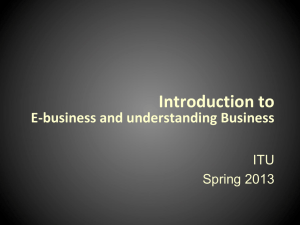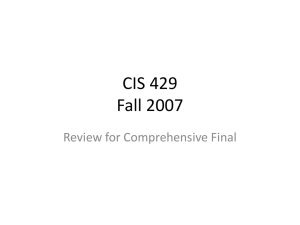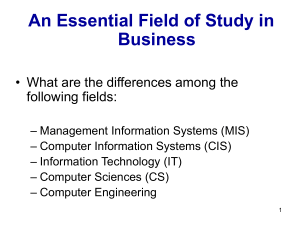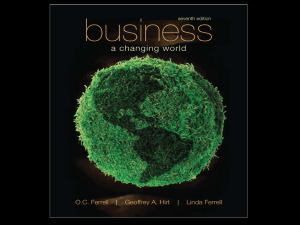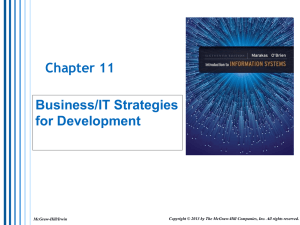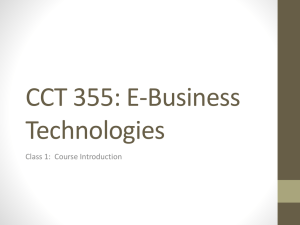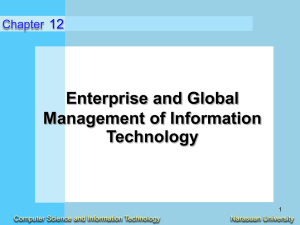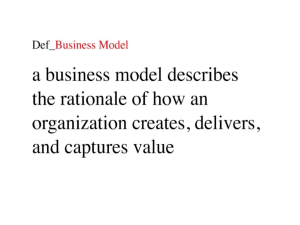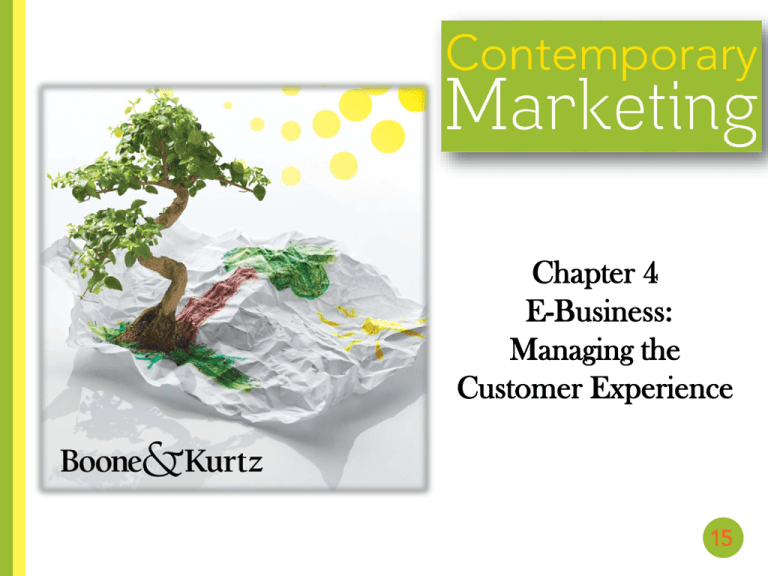
Chapter 4
E-Business:
Managing the
Customer Experience
CHAPTER 4 E-Business: Managing the Customer Experience
Chapter Objectives
1. Describe the growth of Internet use worldwide.
2. Define e-business and e-marketing, and list the opportunities
e-marketing presents.
3. Distinguish between a corporate Web site and a marketing
Web site.
4. List the major forms of B2B e-marketing.
5. Explain business-to-consumer (B2C) e-marketing.
Copyright © 2012 by South Western, a division of Cengage Learning. All rights reserved.
CHAPTER 4 E-Business: Managing the Customer Experience
Chapter Objectives
6. Identify online buyers and sellers.
7. Describe some of the challenges associated with online
marketing and e-business.
8. Discuss how marketers use the communication function of the
Web as part of their online marketing strategies.
9. Outline the steps involved in developing successful e-business
Web sites and identify methods for assessing Web site
effectiveness.
Copyright © 2012 by South Western, a division of Cengage Learning. All rights reserved.
CHAPTER 4 E-Business: Managing the Customer Experience
New E-terms
o
o
o
o
o
o
o
o
E-business
E-marketing
E-commerce
E-tailing
E-zine
E-mail
E-space
E-procurement
CHAPTER 4 E-Business: Managing the Customer Experience
The Digital World
o Almost three-quarters of the U.S. population access
the Internet at home, school, work, or public access
sites
o What do people do online?
o United States – Communication, information, and
purchases
o China – Downloading, streaming music, online gaming,
videogaming, and social networking
Copyright © 2012 by South Western, a division of Cengage Learning. All rights reserved.
CHAPTER 4 E-Business: Managing the Customer Experience
The Digital World
o In spite of the past success and future potential of the
Internet, issues and concerns relating to e-business
remain
o The benefits and potential of e-business outweigh the
concerns and problems
Copyright © 2012 by South Western, a division of Cengage Learning. All rights reserved.
CHAPTER 4 E-Business: Managing the Customer Experience
What is E-Commerce?
o Electronic commerce (e-commerce): Targeting
customers by collecting and analyzing business
information, conducting customer transactions, and
maintaining online relationships with customers by
means of computer networks
CHAPTER 4 E-Business: Managing the Customer Experience
E-Marketing
o Strategic process of creating, distributing, promoting,
and pricing goods and services to a target market over
the Internet or through digital tools
o Application of electronic tools to contemporary
marketing has the potential to:
o Greatly reduce costs
o Increase customer satisfaction
Copyright © 2012 by South Western, a division of Cengage Learning. All rights reserved.
CHAPTER 4 E-Business: Managing the Customer Experience
E-Marketing
o Online marketing - Activities that connect buyers and
sellers electronically through interactive computer
systems
Copyright © 2012 by South Western, a division of Cengage Learning. All rights reserved.
CHAPTER 4 E-Business: Managing the Customer Experience
Copyright © 2012 by South Western, a division of Cengage Learning. All rights reserved.
CHAPTER 4 E-Business: Managing the Customer Experience
What is Interactive Marketing?
o Interactive Marketing
o Buyer-seller communications in which the customer
controls the amount and type of information received
from a marketer through such channels as the Internet,
and virtual reality kiosks.
CHAPTER 4 E-Business: Managing the Customer Experience
What is the Internet?
o Worldwide network of interconnected computers that
lets anyone with access to a personal computer send
and receive images and data anywhere
The Internet
World Internet Users
1990 – Fewer than 1
Million
1995 – 50 Million
2001 – 490 Million
2005 – 766 Million
70% of Internet Users USA
2006 – 50% outside the
USA
The Birth and Rise of
Ecommerce
CHAPTER 4 E-Business: Managing the Customer Experience
o The Internet
o Over 143 million active users in the USA
o Intranets
o Internal corporate network that allows employees within
an organization to communicate with each other and gain
access to organizational information
o Extranets
o Secure network accessible through a Website by external
customers or organization for electronic commerce. It
provides more customer-specific information than a
public site.
CHAPTER 4 E-Business: Managing the Customer Experience
The Internet (1 of 2)
o Taken from the paper “International Internet Marketing
(IIM)” by Philip, R. (2004).
o In 1990, fewer than 1 million users were connected to the Internet. By
1995, the figure had risen to 50 million. In 2001, it grew to 490 million.
In the US, where Internet usage is most advanced, 58 percent of the
population had Internet access at home by July 2001 (Cantrell, 2001).
o The internet has become more powerful with the growing use of
broadband. Broadband permits the rapid transmission of much greater
quantities of information, including moving pictures. In 2002, Korea’s
15 million households had broadband service (Moon, 2002). By 2004,
more than 152 million people in the United States were online with over
one-third having broadband connections (Fost, 2004).
CHAPTER 4 E-Business: Managing the Customer Experience
The Internet (2 of 2)
o In 2000 there were nearly 350 million internet users world-wide
and by 2005 the number of users could be more than double to
nearly 766 million (Wall street journal, 2000).
o Also the number of internet users is growing in other countries;
this should be of concern for firms wanting to enter foreign
markets. For example, although 70% of today’s internet users are
currently based in the United States (Harrison-Walker, 2002),
more research done by Heckman & Schmidt (2000) and Struass
and Frost (2001) predict that by 2005 more than 50% of internet
users will be based outside the US, and that the percent of users in
the European Union will exceed the percent of users in the United
States.
CHAPTER 4 E-Business: Managing the Customer Experience
o Four Web Functions
o Communication
o E-mail; Instant messaging; Chat rooms and bulletin
boards; Online communities
o Information
o Search engines; Online publications; Newsgroups;
Internet forums; Electronic bulletin boards; Web
communities
CHAPTER 4 E-Business: Managing the Customer Experience
o Four Web Functions
o Entertainment
o Games; Radio and TV programming, including
music; Streaming video of live news reports, sports,
and musical performances; Electronic books
o E-Commerce
o Online auctions
o B2B: electronic exchanges; Extranets and private
exchanges
o B2C: Electronic storefronts and cybermalls; Web
kiosks, Online ticketing; Matchmaking
CHAPTER 4 E-Business: Managing the Customer Experience
o Four Web Functions
CHAPTER 4 E-Business: Managing the Customer Experience
o Online Consumer Marketing
o Lower Prices
o Bots (short for robots): programs that check
hundreds of sites, gather and assemble information,
and bring it back to the sender
o Convenience
o Worldwide access, Day or night, Customized
products and information
o Personalization
o Improves the quality of the shopping experience
o Improves customer satisfaction
CHAPTER 4 E-Business: Managing the Customer Experience
o Benefits of Online Consumer Marketing
o Relationship Building
o Crucial to success
o Online’s personalization helps
o Easier for small businesses with small budgets
o Customer service is the key
o Increased Efficiency
o Greater profit margins
o Educating customers online frees salespeople from
answering routine questions
CHAPTER 4 E-Business: Managing the Customer Experience
o Cost Reductions
o Reduced start-up costs
o Reduced operating costs
o Frees funds for new marketing efforts
o www.virtualbank.com
o A More Level Playing Field
o Even small firms with small budgets can compete in
the global marketplace
o Helps eliminate discrimination and allow minority
businesses to succeed on their own merits
o AutoNetwork.com
CHAPTER 4 E-Business: Managing the Customer Experience
Creating an Effective Web Presence
Measuring
Effectiveness
Managing a
Web Site
Creating an
Effective Web Site
CHAPTER 4 E-Business: Managing the Customer Experience
o Building an Effective Web Site
o Establish a Mission for the company’s site
o Identify the purpose of the site
o Satisfy customer needs and wants through a clear site
design
o Managing a Web Site
o Update the site frequently
o Flag new merchandise and services
o Ensure that site appears to be current
o Update software as needed
o Track costs and revenues
MEASURING WEB SITE EFFECTIVENESS
Click-through rate Percentage of people
presented with a banner ad who click on it.
Conversion rate Percentage of visitors to a
Web site who make a purchase.
WEB BUSINESS MODELS
• Corporate Web site Site designed to increase a firm’s
visibility, promote its offerings, and provide information
to interested parties.
• Purpose is to build customer goodwill and assist
channel members in their marketing efforts.
• Other purposes include disseminating financial
information; giving prospective employees the opportunity
to apply online for jobs; and providing a communication
channel for customers and other interested parties.
.• Marketing Web site Site whose main purpose is to
increase purchases by visitors.
• Includes information about company history,
products, locations, employment opportunities, and
financial information.
CHAPTER 4 E-Business: Managing the Customer Experience
Web Business Models
o Corporate Web site - Designed to increase a firm’s
visibility, promote its offerings, and provide
information to interested parties
o Build customer goodwill
o Assist channel members in their marketing efforts
o Marketing Web site - Aim is to increase purchases by
visitors
Copyright © 2012 by South Western, a division of Cengage Learning. All rights reserved.
CHAPTER 4 E-Business: Managing the Customer Experience
B2B E-Marketing
o Use of the Internet for business transactions between
organizations
o Generates sales revenue
o Provides detailed product description when required
o Increases efficiency of business transactions
Copyright © 2012 by South Western, a division of Cengage Learning. All rights reserved.
CHAPTER 4 E-Business: Managing the Customer Experience
B2B E-Marketing
o Tools used:
o EDI
o Web services
o Extranets
o Private exchanges
o Electronic exchanges
o E-procurement
Copyright © 2012 by South Western, a division of Cengage Learning. All rights reserved.
CHAPTER 4 E-Business: Managing the Customer Experience
Proprietary B2B Transactions
o Electronic data interchange
o Exchange of sales information between buyers and
sellers
o Requires compatible hardware and software systems
o Cuts paper flow, speeds the order cycle, and reduces
errors
o Allows companies to set production schedules to better
match demand
Copyright © 2012 by South Western, a division of Cengage Learning. All rights reserved.
CHAPTER 4 E-Business: Managing the Customer Experience
Proprietary B2B Transactions
o Web services
o Internet-based systems that allow parties to
communicate electronically with one another regardless
of the computer operating system they use
o Rely on open source XML standards
o Extranets
o Secure networks used for e-marketing and accessible
through the firm’s Web site by external customers,
suppliers, or other authorized users
Copyright © 2012 by South Western, a division of Cengage Learning. All rights reserved.
CHAPTER 4 E-Business: Managing the Customer Experience
Proprietary B2B Transactions
o Intranets
o Secure internal networks that help companies share
information among employees
o Private exchanges
o A secure Web site at which a company and its suppliers
share all types of data related to e-marketing
o Sometimes called c-business
Copyright © 2012 by South Western, a division of Cengage Learning. All rights reserved.
CHAPTER 4 E-Business: Managing the Customer Experience
E-procurement on Open Exchanges
o E-Procurement - Use of the Internet by to solicit bids
and purchase goods and services from suppliers
o
Offers benefits to the public sector
Copyright © 2012 by South Western, a division of Cengage Learning. All rights reserved.
CHAPTER 4 E-Business: Managing the Customer Experience
B2C E-Marketing
o Selling directly to consumers over the Internet
o Also called e-tailing
o Driven by convenience and improved security for
transmitting financial information
o Service providers such as banks are important
participants in e-tailing
Copyright © 2012 by South Western, a division of Cengage Learning. All rights reserved.
CHAPTER 4 E-Business: Managing the Customer Experience
Electronic Storefronts
o Company Web site that sells products to customers
o Items for purchase are placed in an electronic
shopping cart
o Electronic shopping cart - File that holds items the
online shopper has chosen to buy
o Increased capability of smartphones influence the
growth of online shopping
Copyright © 2012 by South Western, a division of Cengage Learning. All rights reserved.
CHAPTER 4 E-Business: Managing the Customer Experience
Benefits of B2C E-Marketing
o Competitive pricing
o An ideal method for savvy shoppers to compare prices
from dozens of sellers
o Easy price comparisons through bots such as
pricegrabber.com.
o Access and convenience
o Allows customers to place orders from anywhere at
anytime; product tracking
Copyright © 2012 by South Western, a division of Cengage Learning. All rights reserved.
CHAPTER 4 E-Business: Managing the Customer Experience
Benefits of B2C E-Marketing
o Personalized service
o Software analyzes past user purchases to customize
experience
o Goal is to create loyal customers who make repeat
purchases
Copyright © 2012 by South Western, a division of Cengage Learning. All rights reserved.
CHAPTER 4 E-Business: Managing the Customer Experience
Source: Data from Nielsen Online, “Nielsen Provides Topline U.S. Web Data for February 2010,” http://blog.nielsen.com; Data from
Nielsen Online, as cited in “Nielsen Online Reports Topline U.S. Data,” Market Wire, accessed on March 25, 2010.
Copyright © 2012 by South Western, a division of Cengage Learning. All rights reserved.
CHAPTER 4 E-Business: Managing the Customer Experience
Challenges in E-Business and E-Marketing
o Safety of online payment
o Companies have developed secure payment systems to
protect customer information
o Encryption - Encoding data for security purposes
o Secure Sockets Layer - Technology that encrypts
information and provides authentication
Copyright © 2012 by South Western, a division of Cengage Learning. All rights reserved.
CHAPTER 4 E-Business: Managing the Customer Experience
Privacy Issues
o Customers’ top security concern is protection of their
personal information
o Through electronic signatures, parties can enter into
legal contracts online
o Cookies and spyware allow companies to personalize
customers’ Internet experience but also invade users’
privacy
Copyright © 2012 by South Western, a division of Cengage Learning. All rights reserved.
CHAPTER 4 E-Business: Managing the Customer Experience
Privacy Issues
o To reassure customers, many online merchants have
signed on with online privacy organizations such as
TRUSTe
o Companies install firewalls to protect private corporate
data
o Firewall - An electronic barrier between a company’s
internal network and the Internet that limits access into
and out of the network
Copyright © 2012 by South Western, a division of Cengage Learning. All rights reserved.
CHAPTER 4 E-Business: Managing the Customer Experience
Frauds and Scams
o Complaints about Internet fraud are received by the
Internet Crime Complaint Center (IC3)
o Phishing - High-tech scam that uses authentic-looking
e-mail or pop-up messages to get unsuspecting victims
to reveal personal information
o Vishing - Scam that collects personal information
through voice response systems; stands for voice
phishing
Copyright © 2012 by South Western, a division of Cengage Learning. All rights reserved.
CHAPTER 4 E-Business: Managing the Customer Experience
Frauds and Scams
o Payment fraud
o Cardholder fraudulently claims ordered merchandise
was never delivered and asks credit issuer for a
chargeback
Copyright © 2012 by South Western, a division of Cengage Learning. All rights reserved.
CHAPTER 4 E-Business: Managing the Customer Experience
Site Design and Customer Service
o Not all Web sites are well designed and easy to use
o Merchandise delivery and returns pose challenges
o Companies that have brick-and-mortar stores often
have more experience satisfying customers than
Internet-only retailers
Copyright © 2012 by South Western, a division of Cengage Learning. All rights reserved.
CHAPTER 4 E-Business: Managing the Customer Experience
Channel Conflicts and Copyright Disputes
o Channel conflicts - Conflicts among manufacturers,
wholesalers, and retailers
o Conflicts in the area of copyright law
o When a site hosts content to which someone else holds
the rights
Copyright © 2012 by South Western, a division of Cengage Learning. All rights reserved.
CHAPTER 4 E-Business: Managing the Customer Experience
Marketing and Web Communication
o The Internet has four main functions:
o E-business
o Entertainment
o Information
o Communication – most popular function
Copyright © 2012 by South Western, a division of Cengage Learning. All rights reserved.
CHAPTER 4 E-Business: Managing the Customer Experience
Online Communities and Social Networks
o Firms use Internet forums, newsgroups, electronic
bulletin boards, and Web communities that appeal to
people who share common interests
o Social networking sites have grown dramatically
o Example: MySpace, Facebook, and LinkedIn
Copyright © 2012 by South Western, a division of Cengage Learning. All rights reserved.
CHAPTER 4 E-Business: Managing the Customer Experience
Blogs and Podcasts
o Blog - Short for Web log— an online journal for an
individual or organization
o Some blogs incorporate wikis, a Web page that
anyone can edit
o Podcast - Online audio or video file that can be
downloaded to other digital devices
Copyright © 2012 by South Western, a division of Cengage Learning. All rights reserved.
CHAPTER 4 E-Business: Managing the Customer Experience
Blogs and Podcasts
o Corporate blogs can help build brand trust
o Employee blogs present ethical issues
o Companies have strict policies about the content of
employee blogs
o Employees can be disciplined over improper blogging
Copyright © 2012 by South Western, a division of Cengage Learning. All rights reserved.
CHAPTER 4 E-Business: Managing the Customer Experience
Promotions on the Web
o Banner ad - Strip message placed in high-visibility
areas of frequently visited Web sites
o Pop-up ad - Separate window that pops up with an
advertising message
o Preroll video ad - Marketing messages that play before
an online video
Copyright © 2012 by South Western, a division of Cengage Learning. All rights reserved.
CHAPTER 4 E-Business: Managing the Customer Experience
Promotions on the Web
o Widget - Tiny interactive applications that Internet
users can copy and add to their own pages to play
music, video, or slide shows
o Search marketing - Paying search engines a fee to
make sure that the company’s listing appears toward
the top of the search results
o Companies use online coupons to promote their
products
o Example: Procter & Gamble
Copyright © 2012 by South Western, a division of Cengage Learning. All rights reserved.
CHAPTER 4 E-Business: Managing the Customer Experience
Building an Effective Web Presence
o An e-business Web site can:
o Broaden customer bases
o Provide immediate access to current catalogs
o Accept and process orders
o Offer personalized customer service
Copyright © 2012 by South Western, a division of Cengage Learning. All rights reserved.
CHAPTER 4 E-Business: Managing the Customer Experience
Copyright © 2012 by South Western, a division of Cengage Learning. All rights reserved.
CHAPTER 4 E-Business: Managing the Customer Experience
Establishing Goals
o What is the company’s goal for its Web site?
o Objectives for the Web site determines the scope of
the project
o Create and maintain a site in-house or to contract with
outside designers?
Copyright © 2012 by South Western, a division of Cengage Learning. All rights reserved.
CHAPTER 4 E-Business: Managing the Customer Experience
Implementation and Interest
o Content – Determines whether visitors return to a site
o Available resources should be:
o Relevant to viewers
o Easy to access and understand
o Updated regularly
o Written or displayed in a compelling, entertaining way
Copyright © 2012 by South Western, a division of Cengage Learning. All rights reserved.
CHAPTER 4 E-Business: Managing the Customer Experience
Pricing and Maintenance
o Variety of costs:
o Development
o Placing the site on a Web server
o Maintaining and updating the site
o Promoting the site
o Important for a Web site to stay current
Copyright © 2012 by South Western, a division of Cengage Learning. All rights reserved.
CHAPTER 4 E-Business: Managing the Customer Experience
Assessing Site Effectiveness
o Web-to-store shoppers - Consumers who use the
Internet as a tool to aid them at brick-and-mortar
retailers
o Click-through rate - Percentage of people presented
with a banner ad who click on it
o Conversion rate - Percentage of visitors to a Web site
who make a purchase
o Engagement - Amount of time users spend on sites
Copyright © 2012 by South Western, a division of Cengage Learning. All rights reserved.
CHAPTER 4 E-Business: Managing the Customer Experience
Copyright © 2012 by South Western, a division of Cengage Learning. All rights reserved.
CHAPTER 4 E-Business: Managing the Customer Experience
Video
Watch E-Business at Evo
o Aside from offering good prices, how does evogear.com offer
value to the consumer?
o Evo has opened a large brick-and-mortar store/community art
space in Seattle, Washington. Go to culture.evogear.com/
category/seattle/ to learn more about what the store offers. Do
you think this store will distract or enhance the Web site?
Consider potential channel conflicts, pricing strategy,
convenience, and consumer behavior in your answer.
Copyright © 2012 by South Western, a division of Cengage Learning. All rights reserved.



